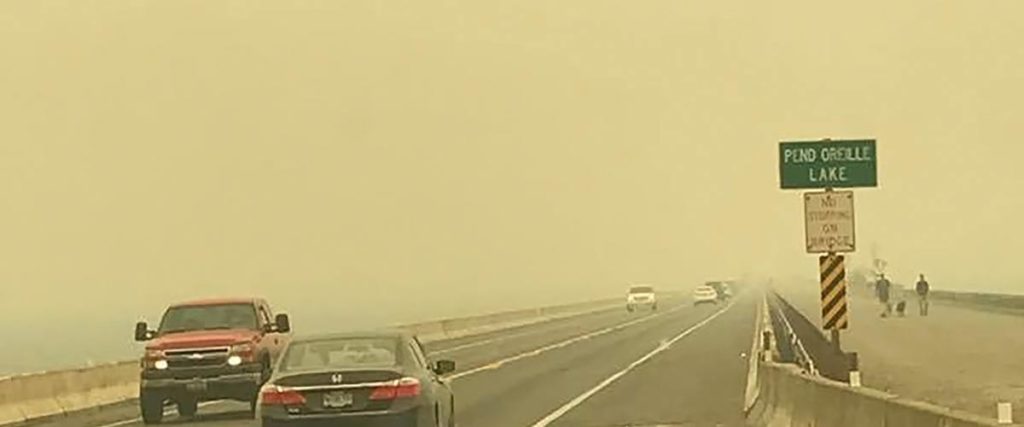Where there’s smoke
From the Summer 2018 Issue
By Jackie Hanson

Even from afar, fires can create dangerous conditions
Sandpoint and its residents didn’t have to see last summer’s fires to feel their adverse effects. As the geographical vortex into which dense brownish smoke from numerous surrounding fires poured, for one day Sandpoint experienced its worst air quality on record. On Labor Day, 2017, the day the above photo was taken, the Environmental Protection Agency rated the Air Quality Index in Sandpoint as worst in the nation, scoring 418 out of a possible 500 on the agency’s pollution scale.
Good air quality, according to the EPA, is when the AQI is from 0–50, although even Moderate quality (51–100) shouldn’t pose a significant risk to most populations. From there, the AQI climbs to Unhealthy for Sensitive Groups (101–150), Unhealthy (151–200) and Very Unhealthy (201–300), which triggers a health alert for all populations, not just the vulnerable. The EPA considers anything above 300 as Hazardous, indicating dangerous levels of ground-level ozone, particle pollution, carbon monoxide, nitrogen dioxide, and/or sulfur dioxide.
For otherwise healthy people, smoke causes itchy, burning eyes, a runny nose, throat irritation, even headaches or nausea. Yet for vulnerable populations, smoke can be hazardous at best, and fatal in the worst cases. Most at risk, according to Panhandle Health District: people who have chronic heart or lung diseases, the very young and very old, pregnant women and diabetics.
Pets and livestock are affected by smoke, too, according to the American Veterinary Medical Association. They advise providing ample fresh water, limiting outdoor exposure, having an evacuation kit and plan ready, and monitoring animals with existing health issues. In addition, livestock should not be handled or moved for 4 to 6 weeks after air quality has returned to normal.
Surviving a smoke event, not unlike surviving a fire, is part preventative and part reactive. The EPA’s website at www.AirNow.gov recommends people stay indoors if advised, run the air conditioner (but close fresh air intakes), and don’t do anything to stir up fine particles in the air, including vacuuming.
An over-the-counter way to protect your lungs is a mask specifically designated as a particulate respirator—despite those pictures often seen on Facebook, surgical masks offer no protection—with the words NIOSH and either N95 or P100 printed on the mask. Available from most hardware stores and some pharmacies, the mask should have two straps to securely cover mouth, nose and chin and must be replaced when it becomes clogged.
Regardless of your health, it’s always a good idea to stay informed of changes to air quality as situations can and do change rapidly when smoke is in the air.
Carrie Scozzaro




Leave a Reply